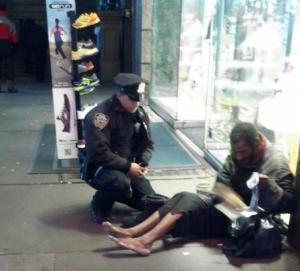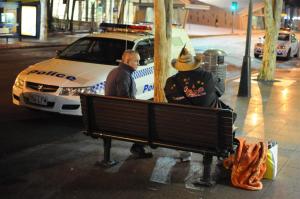The image of a New York policeman giving a homeless man boots and socks recently became a global internet sensation. Later, we discovered that the homeless man wasn’t in fact homeless and helpless. It turned out that 54-year old Jeffrey Hillman had an apartment in the Bronx. Hillman, who served in the military, is eligible for support through the federal Housing and Urban Development’s Veterans Affairs Support Housing program. A few days later he was back on streets without the boots and seemingly unaffected by the cop’s well-publicized act of generosity. Whatever the outcome, patrolman Larry DePrimo deserves credit for helping out. It’s certainly a better look than shooting suspects or harassing minorities to maintain crime stats to keep tough-talking politicians in office.
Former Victoria Police chief commissioner Mick Miller likes to say that where there is an oppressive regime it is invariably the police officer who is the instrument of oppression. In response to public concern about law and order, modern police forces often take on the look of an occupying force. It’s costly and rarely works. Look at Victorian Premier Ted Baillieu’s half-baked plan to recruit 1000 protective services officers to patrol suburban railway stations. A report in The Age this morning suggests they spend most of their time dishing out fines to the intellectually impaired, the homeless and naughty teenagers. It’s only a matter of time before one of the bored and poorly trained PSOs shoots someone because they don’t have enough to do, said one pundit. Why they need guns when their primary function appears to be revenue collection is another matter.
What’s often forgotten is that the job of police is not just to enforce the law. Part of their role is to be peace officers too. The Jeffrey Hillman story reminded me of this. So here’s another unsung cop hero whose story should be an example to all police walking the beat.
Senior Sergeant Corey Allen of Brisbane City Police has helped nearly 200 homeless men find housing in the past two years.
Corey has also changed the culture of Brisbane city police station which faced international outrage in 2006 when a YouTube clip of officers attacking an elderly homeless man went viral. The man, 67-year Bruce Rowe, had recently lost his wife of 41 years and was at the lowest ebb of his life.
Corey says that police have helped reduce homelessness by 37 per cent in two years, mainly by talking to the street dwellers and finding out the reason for their predicament. Under his leadership, his members have become “forward scouts” in connecting vulnerable people to welfare, housing and health services.
Officers uncovered a hidden epidemic of prescription drug abuse which had previously fuelled street crime in Brisbane.
Previously, police had focused exclusively on illegal drugs but now understand the link between crime and abuse of legal drugs like painkillers and sleeping tablets, he says. Now they understand that much of the anti-social behavior of street dwellers and vulnerable people living in decrepit boarding houses is related to abuse of prescription drugs, plus alcohol and other drugs. Almost all categories of crime have fallen in Brisbane city since police have tackled the homeless problem with compassion and enlightenment.
Martin Dowlan, 41, had been homeless for 15 years after a family breakdown until approached by two officers in September who asked him if they could help.
“We used to get harassed all the time by police but when these two came to me one night I put my hand up for some help and guidance,” he told me. Just like Jeffrey Hillman, Martin had rejected the offers of help, either through suspicion of the motives or a lack of back up and support.
Martin has recently been given housing in South Brisbane and has reconnected with his family, after help from police.
A single act of kindness by New York patrolman Larry DePrima has drawn global praise and more than half a million “likes” on the NYPD Facebook page but it pales by comparison with what Brisbane city police are doing night after night.
Corey freely admits that his officers had a brutal approach when dealing with the homeless.
In 2006, four officers in Brisbane’s Queen Street Mall had pinned Bruce Rowe on the ground while one repeatedly drove his knee into his leg. The police had dragged Mr Rowe out of a public toilet after he disobeyed a “move along” order.
Corey says police have stopped seeing the homeless people as a problems that prevent them from tackling “real crime.”
Previously, police arrested street people for drunkenness or failing to obey a move on direction to get them to a safe place for a few hours.
The turning point came when city police participated in a 2010 survey called 50 Lives 50 Homes with homeless services agency Micah Projects.
“We surveyed all the homeless people every day at 4am for a week and asked them questions on health and well-being. We spoke to the people with the highest level of morbidity and they were all the people we knew, first name,” he says.
In the past two years police, working alongside Micah Projects, have found permanent homes for nearly 200 people.
“We have got enough connections and there is enough housing to accommodate every homeless person in the CBD of Brisbane. I could get them a house tomorrow, no problem but I can’t get them to say yes to it. There’s a massive history of social dysfunction and mistrust, mental health alcohol and drug use,” he says.
The extent of the cultural change was recognised in March when the Brisbane City Police Station was named as a finalist in the National Homelessness Awards and they aren’t even a homelessness service provider.
Corey stresses the importance of old fashion beat policing when dealing with vulnerable people.
“A 1965 policeman’s manual gives you a guide on how to walk the beat. You’re responsible for what happens on your beat. You make yourself known to characters of ill-repute and move them on where appropriate,” he says.
“Two police on the beat are really masters of their own destiny or failure. They can walk around and do a really good job or be reviled by the people around them.”
I like seeing police walking the beat. I like it even better when I see them talking to people. It’s not easy to start up 50 conversations a day with people you don’t know, especially when there is a background of mistrust. You change that image one conversation at a time.
I met Corey at a law enforcement and public health conference in Melbourne last month. At first he was reluctant to talk to me, such is the battering that Queensland police have copped over the years. But after we broke the ice, he worked out that I wasn’t too bad after all. So I guess trust works both ways. As reporters, we need to tell more of the good stories, if we want to have better police generally.


I was shocked to learn police had bashed that man but relieved to read they had revised their approach.
Your final comment is important – we need to reflect humanity in our media coverage, it’s part of the story too.y
Thanks Jan I agree. As the business model comes under pressure there is a tendency to become more shrill and conflict seeking in the media when in fact it is about connecting to the concerns and desires of our market. That’s about a balance of positives and negatives. The good stories tend to be saccharine sweet with puppies and flowers rather than life affirming in a more practical sense.
Bravo Adam! More balanced reporting and who knows… perhaps the domino effect will help change this imperfect society we have all created.